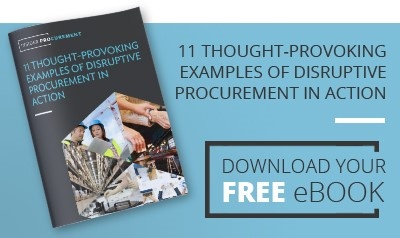Disruptive procurement is the process of creating real business value and competitive advantage by:
- deconstructing what the business really needs,
- challenging established business processes,
- leveraging knowledge from outside the normal points of reference, and
- designing, assembling and managing the supply chain in new and innovative ways.
“Disruptive procurement” uses knowledge of the entire supply chain to challenge requirements and drive out business benefits far in excess of any improvements in margin.
Those who practice truly disruptive procurement understand both the value that their organisation delivers to its clients and the value that suppliers create for them.
Some great examples of this are found in our eBook "11 thought-provoking examples of disruptive procurement in action".
Those who practice Disruptive Procurement are prepared to challenge the norm and examine organisational requirements from a position of in-depth knowledge of the product category or service line they are responsible for.
In doing so they aim to incrementally grow the value to the organisation as well as maintaining constructive supplier relationships.
Disruptive procurement is needed because in many cases the old school style of procurement of simply focusing on price is no longer enough in today’s fast moving market.
Now, let’s look at those 7 key ingredients of disruptive procurement:
- Look at everything through fresh eyes
- Understand how your business drives stakeholder value
- Know your supply chain inside out
- Learn from other industries
- Find the real need
- Find innovative ways to drive out cost
- Think like an HR Director – focus on cultural fit and values
1 - Look at everything through fresh eyes
This is one of the fundamental elements of disruptive procurement.
As young children most of us will have gone through a phase of asking “Why?”. Driving our parents mad as we sought to understand more about the world we live in and our place within it.
As we grow up, asking why becomes a risky question. We stop asking the dumb questions for fear of losing our expert status and consequently become entrenched in the status quo.
But it is only through incisive questioning that we have any chance of making real improvements.

How will committing to these huge capital purchases move the business forward? What finance structure (buy, lease, hire, JV etc) aligns best to our financial objectives? How can we improve the financial position for our shareholders through this deal?
Why do we still make that model of product when the component parts are difficult to source? Is it time for a redesign?
We’ve always bought locally. Who could help us open up our supply chain to global players?
We’ve always sourced from overseas. What advantages would a local supplier bring and how do they help us accelerate value in the business?
The possibilities are endless when you simply look for them!
2 – Understand how your business drives stakeholder value
Historically, most procurement teams have focused primarily on reducing price and this has ultimately meant understanding supplier margins and working out ways to reduce them.
Airfreight, technology and communications have opened up the global supply chain, introduced competition and driven down costs. For many that never-ending round of cost reductions (buying the same thing for less) is just about over. Suppliers don’t have the margin to chip away at, and in many cases input costs such as currency, raw materials, disposal and labour costs are increasing through both legislation and market action.
Procurement has to change tack if it is to remain relevant.
By understanding how the business drives stakeholder value, procurement can play a huge part in maximising overall success. Let's look at two simple examples:
Example 1 – Giving employees a say boosts productivity
It is widely recognised that improved employee satisfaction can lead to increased productivity. In fact, a UK based study by the Social Market Foundation and the University of Warwick’s Centre for Competitive Advantage in the Global Economy found that happy employees are an average of 12% rising to up to 20% more productive.

Consider the purchase of uniforms as an example.
The buyer may consider that it would be too complicated to seek employee opinions. You could have multiple opposing views. The cost might actually increase….these are all reasons that an old school procurement team might use for not seeking employee opinions.
Instead let’s imagine the situation where, as a result of employee consultation, the price of uniforms actually increased by £5 each and each employee has received 4 uniforms per year. The exercise has just cost the business an extra £20 per employee per year. With 1000 employees in the business that is an extra cost of £20,000 annually.
But, what if employee satisfaction improved (no more uncomfortable trousers, better visibility etc), and that led to an increase in productivity of just 5%?
If each employee earns the business £100 per day, that increase in productivity would result in increased gross profit of £5 per employee per day.
Let’s calculate the net profit / loss.

You may be able to factor in increased employee retention too.
Now, this is a very simple example, but it serves to illustrate the point that if procurement teams get involved in delivering stakeholder value, they have the ability to have an even more significant impact on the bottom line.
Example two – Printing menus for a national chain of restaurants
Suppose you operated a national chain of restaurants. A traditional procurement expert might calculate that ordering printed menus in bulk at the start of each season would be deliver menus at the lowest price.
They would go out to tender for the bulk creation of menus all to the same specification.
 On closer examination of the business, however, they would understand that in areas with a lot of local competition, the restaurant manager may well want to adjust pricing at short notice. Being able to adapt pricing to suit the local area may attract more customers and increase profitability. In other words, a one-price-fits-all mentality could impede profitability and business growth.
On closer examination of the business, however, they would understand that in areas with a lot of local competition, the restaurant manager may well want to adjust pricing at short notice. Being able to adapt pricing to suit the local area may attract more customers and increase profitability. In other words, a one-price-fits-all mentality could impede profitability and business growth.
The disruptive procurement professional would, on understanding this balance, define the requirements as short run, short lead time, on brand print production.
3 - Know your supply chain inside out
It stands to reason that getting a grip on what’s happening in your supplier base puts you in a stronger position to work collaboratively for mutual gain.
With a global market comes huge opportunities and huge complexity in the procurement process. New suppliers are emerging, old ones disappearing and the way that they do business with their suppliers is changing too. Technology is changing at a rapid pace and innovation and change is the only certainty.
Those who excel amidst this complexity recruit knowledge and experience from inside their supply chain.
They work with people who know about the margins, rebates and retrospective discount schemes open to their suppliers.
They collaborate with designers, architects and project managers to devise new solutions that take advantage of reduced price options.
They have the inside track on suppliers’ business goals and know the levers available for negotiation.
4 - Learn from other industries
Disruptive procurement is about doing things differently. “Best practice” within your own industry is certainly something to keep an eye on, but some surprising insights can be gained by taking time to understand and apply practices from other, seemingly unrelated, industries.
Let me give you a couple of examples:
Example one - Software developers learning from the car industry
The automotive industry was among the first to introduce production methods that limited the amount of stock held within the process. Kanban (which is the Japanese term for visual sign or card) was invented at Toyota. The method of passing tokens back and forth to represent stock usage and requirements.
This was later applied to the software industry where packages of work are made available and software team members pull work packages as capacity allows rather than work being pushed onto them. The result is increased efficiency because developers can start on a package of work knowing that any dependencies have already been thought through in the planning process.
Example two - Project managers learning from rugby teams
In rugby, a scrum is used to restart play. The term has been adopted by project managers and product development terms, to denote the way in which teams stop and start in reaction to elements beyond their control, whilst still aiming for the same goal.
In a situation where the customer requirements are not entirely known up front, software developers use a scrum approach to work together to quickly get the software to the next stage, pause to check assumptions, variations and requirements and move on to the next stage. This stop-start approach facilitates quick response corrective movements whilst still heading towards the same goal.
A website developer may, for example, agree on the menu structure, look and feel and overall messaging as the first scrum. Thereafter, other pages will be built out and fresh ideas can be incorporated that were not envisaged at the start of the project.
5 – Find the real need
Good buyers take time to understand and deliver on the requirement. Excellent buyers understand and deliver on the need.
Some buyers, like those buying raw materials work to a very prescriptive set of requirements and may not think they can influence or change the very basic need. However, it depends how you express that need.
A food processor may need sugar. There are several sources of sugar in the world and the price is very much commodity driven. Buyers in this case look at the total cost – the cost of delivery, storage and so on as well as the product cost in order to work out the most cost efficient route. The need in this case might be for sugar to be delivered at set times and in set quantities each week. Reliability and quality will be key criteria.

But for those buying goods not for resale (GNFR), and those involved in very complex purchases (e.g. property directors purchasing land, construction and refits), there are huge opportunities to question the real need.
Being asked to lower the cost of a maintenance contract for example, could be looked at as a negotiation on the contractor’s hourly rate. Dig a little deeper and you could find that the “real need” is to reduce the total cost of ownership. In which case, reviewing the cost benefit of a phone based triage service aimed at reducing the number of maintenance call-outs may be a more cost-effective solution.
Uncovering the real need can lead to a different purchase requirement, a whole new set of suppliers and a very different total cost of ownership or profit margin.
6 – Find innovative ways to drive out cost
Price is the price you pay for the goods. Cost is the overall cost of providing those items.
There are several ways to drive out cost:
1 – Buy less
If the uniform supplier will only supply a minimum order quantity of 100 uniforms then you will need storage space for the “spares”. If you are a multi-location operation, where is the most cost-effective place to store them and how are they distributed from there to those who need them?
Would it be cheaper to go for a supplier who supplies on demand for some items in order to reduce storage costs?
2 – Review the functional requirement
Whilst the “need” described in “ingredient 2” above referred to the item plus quality, delivery and other attributes, here we are delving deeper to ask about the functional requirement of the item to be purchased.
For example, if the procurement team is asked to purchase PCs they might enquire about the need and discover that cheaper diskless workstations would perform the same function.
3 – Know the "should cost" for every element of the purchase
Breaking down an item into its constituent parts, knowing the costs for each and building up a picture of what it “should cost” is a commonly used technique where an item has never been purchased before. It disrupts the sales process and gives procurement a way of understanding the pure cost base helping the team to establish what it should be paying.
7 – Think like an HR Director – focus on cultural fit and values when choosing suppliers
Having just reflected on how increasing employee satisfaction leads to increased productivity, let’s turn our attention to the importance of relationships more generally.
Procurement and HR directors perform a surprisingly similar role. Some top performing businesses such as Jaguar Land Rover are even starting to combine the roles given the natural synergies.
They both obtain assets that are to be used to deliver the business’ objectives.
They are both concerned with cost, performance, quality and other factors when they make their decisions.
However, surprisingly few procurement heads look at organisational fit in the same way that an HR director does. High performing procurement teams understand exactly how this impacts the bottom line in the same way that an HR director would.
It’s easy to see how, if you employ a person that isn’t a good cultural fit, several things could happen:
- They decide to leave quickly and your investment in training is lost
- They cause other people to leave and a longer term investment in training and knowledge is lost
- They don’t leave and nobody else does but productivity suffers, management time increases and stress levels increase which further impacts productivity
- Perhaps they are such a bad fit that they don’t heed safety regulations and someone gets hurt, or the don’t take notice of instructions and break equipment
- Or maybe their work ethic is poor and they disrupt the rest of the workforce
The list goes on….HR leaders know that scenario well.
Working with a supplier that is not a good cultural fit can create an additional burden on several areas of the business. Late deliveries, quality problems, incorrect deliveries, badly managed supplier systems and processes can all have a negative impact on your business - especially in terms of the time and effort involved to resolve each issue as it arises.
They could impact employee satisfaction, customer satisfaction and productivity. They may technically supply your requirements at a low price, but are they the lowest COST in terms of what you are trying to achieve?
A good fit supplier, on the other hand, thinks like you do.
They are approachable, open to new ideas, willing to work through any issues to find a solution that works going forwards, not just a quick fix to the current problem.
Back to our uniform example. If you agreed a higher priced uniform in order to satisfy employees and get those productivity gains, but the supplier you chose operated on a different sizing scale meaning that the new uniforms didn’t fit a large proportion of the workforce, the gains you made on employee satisfaction would be quickly eroded if the supplier was not willing and able to adjust their clothing pattern templates.
Of course, they are able to do it. It is the willingness to do it in a short time frame that counts.
Judging cultural fit is the subject of another blog: 6 questions to ask in order to determine cultural fit in procurement.
Our procurement consultants put together an eBook "11 thought-provoking examples of disruptive procurement in action" to show how this inside knowledge across supply chains can lead to a mutual win-win and lower costs all round.


